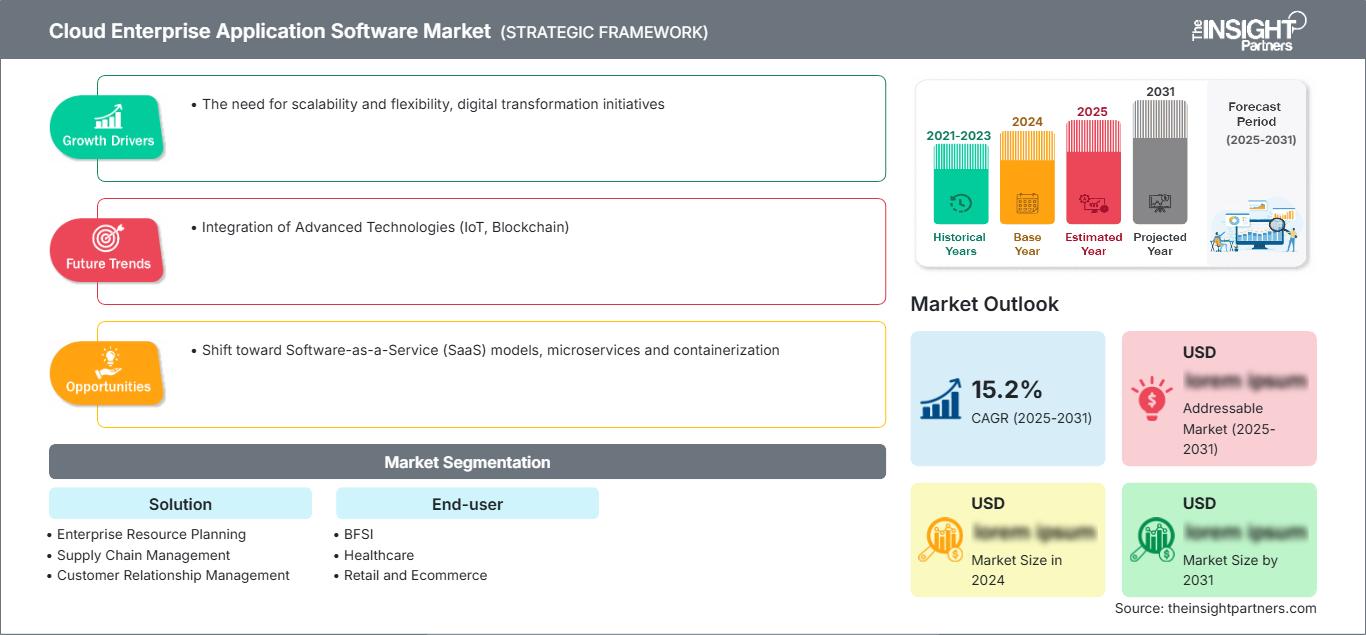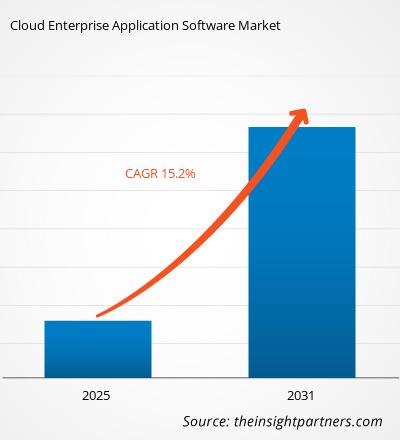页面已更新 :
Sep 2024
预计 2023 年至 2031 年期间,云企业应用软件市场的复合年增长率将达到 15.2%。向软件即服务 (SaaS) 模式、微服务和容器化的转变可能仍将是市场的主要趋势。
云企业应用软件市场分析
- 此类别包含通过 Web 交付并可通过任何浏览器访问的企业应用程序。这些面向业务的应用程序被大型组织使用,以帮助其更高效地运营,通常由第三方供应商托管,而不是由公司自行存储和管理。
- 云企业应用软件正在迅速普及。一些大型公司正在用基于云的解决方案取代其本地部署解决方案,因为它们更加灵活、经济且易于升级。
- 云应用程序和共享计算被广泛应用的一些领域包括金融领域、医疗保健行业、制造业等。然而,在所有优势的背后,人们对数据安全和行业合规性存在着特殊的担忧。
云企业应用软件市场概览
- 公司包括 SAP、Oracle、Salesforce、Microsoft 等。市场按应用程序类型(定义为 ERP、CRM、SCM 等)和行业垂直领域划分。
- 人工智能、物联网和分析正在影响产品供应。使用云解决方案的中小企业数量仍在增加。
- 新冠疫情推动了云计算的采用,远程办公的需求也随之增加,导致对基于云的协作和生产力软件的需求增加。
自定义此报告以满足您的要求
您将免费获得任何报告的定制,包括本报告的部分内容,或国家级分析、Excel 数据包,以及为初创企业和大学提供超值优惠和折扣
云端企业应用软件市场: 战略洞察

- 获取本报告的主要市场趋势。这个免费样本将包括数据分析,从市场趋势到估计和预测。
自定义此报告以满足您的要求
您将免费获得任何报告的定制,包括本报告的部分内容,或国家级分析、Excel 数据包,以及为初创企业和大学提供超值优惠和折扣
云端企业应用软件市场: 战略洞察

- 获取本报告的主要市场趋势。这个免费样本将包括数据分析,从市场趋势到估计和预测。
云企业应用软件市场驱动因素和机遇
需要可扩展且灵活的 IT 解决方案来支持市场
- 与此同时,可扩展的基于云的解决方案消除了前期对大量硬件和基础设施相关投资的需要,因为您只需为您使用的内容付费。
- IT 需求快速增长的公司可以快速扩展规模,避免因自负盈亏修复基础设施而导致的延误。
- 具有季节性或周期性需求的企业(例如零售业)可以在真正需要的时候扩展其 IT 资源。
- 可扩展的云平台可以更快地部署新功能和新技术,支持持续创新。
- 灵活的基于云的解决方案可让您从任何地方安全地访问功能。
先进技术(物联网、区块链)的集成
- 此过程 -将物联网和区块链等核心技术集成到云企业应用软件中,将带来前所未有的增长机遇,实现安全、实时的数据和操作流畅无阻。
- 大量物联网设备持续收集海量数据。利用区块链技术,这些数据可以安全地收集并存储在云端。
- 在 Oracle 云中,高级分析(包括人工智能和机器学习)可以处理和分析数据,从而获得切实可行的洞察。这些洞察可以通过智能合约自动执行,也可以由物联网设备实时执行——创造所需的闭环。
- 这种集成方法使现有产品能够不断通过新的尖端功能得到增强,刺激新的细分市场,识别和满足新兴的业务需求,提高安全性和透明度,实现新的业务模式,并吸引新一代具有前瞻性思维的客户。
- 因此,通过使用这些新技术增强其云企业应用程序,企业可以在多个垂直行业中享受更高的运营效率、更明智、更快的决策和更好的业务成果。
云企业应用软件市场报告细分分析
有助于得出云企业应用软件市场分析的关键细分市场是解决方案和最终用户。
- 基于解决方案,云企业应用软件市场分为企业资源计划 (ERP)、供应链管理 (SCM)、客户关系管理 (CRM)、商业智能 (BI)、网络会议、业务流程管理 (BPM)、内容管理系统 (CMS)、企业资产管理 (EAM) 等。
- 基于最终用户,云企业应用软件市场分为 BFSI、医疗保健、零售和电子商务、政府、石油和天然气、制造业和其他。
按地区分析云企业应用软件市场份额
- 云企业应用软件市场报告对五个主要地理区域进行了详细分析,包括当前和历史市场规模以及 2021 年至 2031 年的预测,涵盖北美、欧洲、亚太地区 (APAC)、中东和非洲 (MEA) 以及南美洲和中美洲。
- 每个区域进一步细分为相应的国家/地区。本报告提供对 18 个以上国家/地区的分析和预测,涵盖云企业应用软件市场动态,例如影响区域市场的驱动因素、趋势和机会。
- 此外,该报告还涵盖 PEST 分析,其中涉及研究影响这些地区云企业应用软件市场的主要因素。
云企业应用软件市场
The Insight Partners 的分析师已详尽阐述了预测期内影响云企业应用软件市场的区域趋势和因素。本节还讨论了北美、欧洲、亚太地区、中东和非洲以及南美和中美洲的云企业应用软件市场细分和地域分布。
云企业应用软件市场报告范围
| 报告属性 | 细节 |
|---|---|
| 市场规模 2024 | US$ XX million |
| 市场规模 2031 | US$ XX Million |
| 全球复合年增长率 (2025 - 2031) | 15.2% |
| 历史数据 | 2021-2023 |
| 预测期 | 2025-2031 |
| 涵盖的领域 |
By 解决方案
|
| 覆盖地区和国家 | 北美
|
| 市场领导者和主要公司简介 |
|
云企业应用软件市场参与者密度:了解其对业务动态的影响
云企业应用软件市场正在快速增长,这得益于终端用户需求的不断增长,而这些需求又源于消费者偏好的不断变化、技术进步以及对产品优势的认知度不断提升等因素。随着需求的增长,企业正在扩展其产品线,不断创新以满足消费者需求,并抓住新兴趋势,从而进一步推动市场增长。

- 获取 云端企业应用软件市场 主要参与者概述
云企业应用软件市场新闻及最新动态
云企业应用软件市场评估通过收集一手和二手研究的定性和定量数据进行,这些数据包括重要的企业出版物、协会数据和数据库。云企业应用软件市场的一些发展如下:
- 甲骨文公司今日宣布,基于 Oracle 云基础设施超级集群的 NVIDIA AI Enterprise 现已在 Oracle 美国政府云区域推出,以帮助解决主权 AI 问题。在扩大合作伙伴关系的基础上,甲骨文和 NVIDIA 正在帮助美国政府客户训练和部署 AI 解决方案,并访问 Oracle 云基础设施的 100 多项服务,包括在高性能加速器(包括 NVIDIA H100 和 NVIDIA A100 Tensor Core GPU)上运行的生成式 AI 服务,以及超低延迟网络和安全存储。 (来源:Oracle,新闻稿,2024 年 4 月)
云企业应用软件市场报告覆盖范围和可交付成果
“云企业应用软件市场规模和预测(2021 年 - 2031 年)”报告提供了涵盖以下领域的市场详细分析:
- 云企业应用软件市场规模以及涵盖范围内所有关键细分市场的全球、区域和国家/地区预测
- 云企业应用软件市场趋势以及市场动态,例如驱动因素、限制因素和关键机遇
- 详细的 PEST/波特五力模型和 SWOT 分析
- 云企业应用软件市场分析涵盖关键市场趋势、全球和区域框架、主要参与者、法规和最新市场发展
- 行业格局和竞争分析涵盖市场集中度、热图分析、知名参与者和云企业应用软件市场的最新发展
- 详细的公司简介
- 历史分析(2 年)、基准年、预测(7 年)及复合年增长率
- PEST和SWOT分析
- 市场规模、价值/数量 - 全球、区域、国家
- 行业和竞争格局
- Excel 数据集
近期报告
相关报告
客户评价
购买理由
- 明智的决策
- 了解市场动态
- 竞争分析
- 客户洞察
- 市场预测
- 风险规避
- 战略规划
- 投资论证
- 识别新兴市场
- 优化营销策略
- 提升运营效率
- 顺应监管趋势
我们的客户































87-673-9708

ISO 9001:2015



 获取免费样品 - 云端企业应用软件市场
获取免费样品 - 云端企业应用软件市场